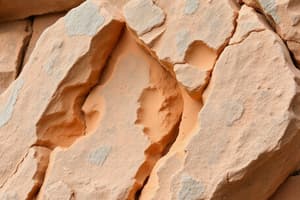Podcast
Questions and Answers
Stress is the adjustment a rock makes when it is subjected to a strain.
Stress is the adjustment a rock makes when it is subjected to a strain.
False (B)
In general, rocks are better able to handle compressional stress than tensional stress.
In general, rocks are better able to handle compressional stress than tensional stress.
True (A)
In general, an arch-shaped fold in sedimentary rock layers is called an aniline.
In general, an arch-shaped fold in sedimentary rock layers is called an aniline.
True (A)
What is the name given to the force which tends to pull rocks apart?
What is the name given to the force which tends to pull rocks apart?
The way a given rock responds to a stress depends on what factors?
The way a given rock responds to a stress depends on what factors?
A rock that experiences plastic strain in response to stress:
A rock that experiences plastic strain in response to stress:
The chief difference between a joint and a fault is that:
The chief difference between a joint and a fault is that:
When the hanging wall slips downward toward the foot wall, the fault is called:
When the hanging wall slips downward toward the foot wall, the fault is called:
Compared to an earthquake of magnitude 5, an earthquake of magnitude 7:
Compared to an earthquake of magnitude 5, an earthquake of magnitude 7:
The Sierra Nevada in California is a classic example of:
The Sierra Nevada in California is a classic example of:
Study Notes
Stress and Rock Response
- Stress refers to how rocks adjust under strain, but it is not inherently true that rocks can always handle stress well.
- Rocks generally respond better to compressional stress compared to tensional stress.
Types of Folds and Forces
- An arch-shaped fold in sedimentary rock layers is termed an "antcline."
- Tensional stress is the specific force that pulls rocks apart.
Rock Response Variables
- A rock's response to stress is influenced by temperature, the rate at which stress is applied, and the confining pressure exerted on it.
- Rocks experiencing plastic strain cannot revert to their original shape after stress release.
Joints vs. Faults
- The main distinction between a joint and a fault is that joints involve fractures without relative movement, while faults involve displacement.
Fault Types
- A normal fault occurs when the hanging wall descends relative to the foot wall.
Earthquake Magnitudes
- An earthquake with a magnitude of 7 results in 100 times more ground movement than one with a magnitude of 5.
Geological Features
- The Sierra Nevada mountain range in California exemplifies geological features resulting from faulting and upthrusting.
Studying That Suits You
Use AI to generate personalized quizzes and flashcards to suit your learning preferences.
Description
Explore the fascinating world of geology with this quiz focusing on how rocks respond to stress and the various types of folds and faults. Test your understanding of key concepts such as compressional and tensional stress, as well as the impact of temperature and pressure on rock behavior. Learn to differentiate between joints and faults while examining earthquake magnitudes.




